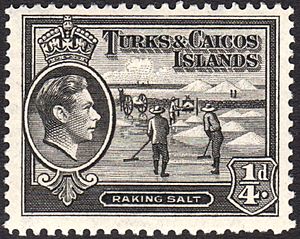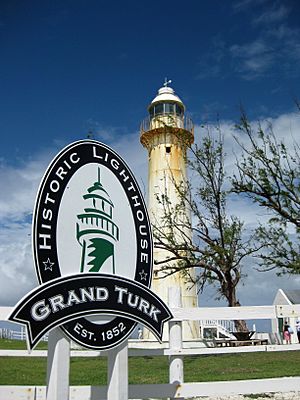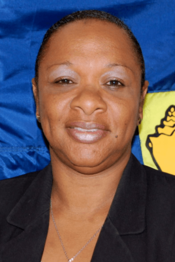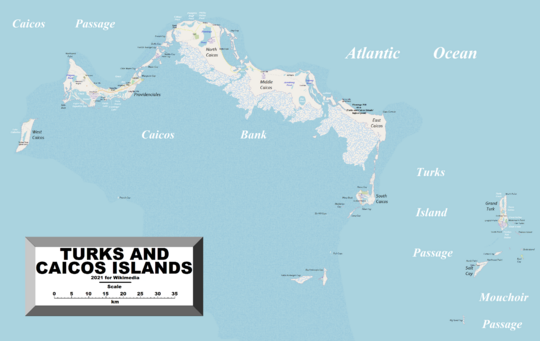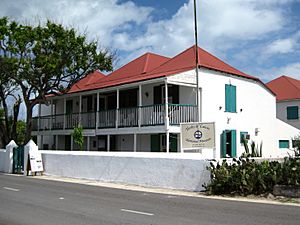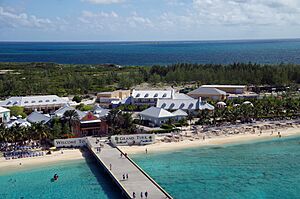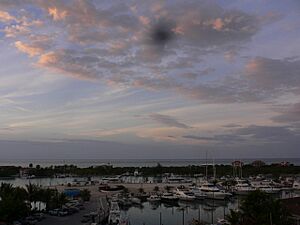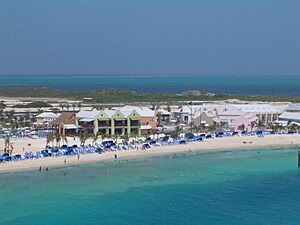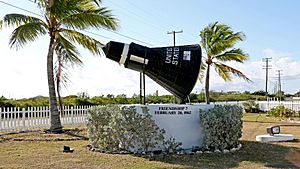Turks and Caicos Islands facts for kids
Quick facts for kids
Turks and Caicos Islands
|
|||
|---|---|---|---|
|
|||
| Anthem: "God Save the King" | |||
| National song: "This Land of Ours" | |||
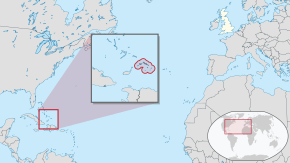
Location of Turks and Caicos Islands (circled in red)
|
|||
| Sovereign state | |||
| Treaty of Paris | 3 September 1783 | ||
| Federation | 3 January 1958 | ||
| Separate colony | 31 May 1962 | ||
| Capital | Grand Turk (Cockburn Town) | ||
| Largest city | Providenciales | ||
| Official languages | English | ||
| Ethnic groups | 88% Afro-Caribbean 8% Euro-Caribbean 4% Mixed or Indo-Caribbeans |
||
| Demonym(s) | Turks and Caicos Islander, Turks Islander, Caicos Islander | ||
| Government | Dependency under constitutional monarchy | ||
|
• Monarch
|
Charles III | ||
|
• Governor
|
Dileeni Daniel-Selvaratnam | ||
|
• Deputy Governor
|
Anya Williams | ||
|
• Premier
|
Washington Misick | ||
| Legislature | House of Assembly | ||
| Area | |||
|
• Total
|
948 km2 (366 sq mi) | ||
|
• Water (%)
|
negligible | ||
| Highest elevation | 48 m (157 ft) | ||
| Population | |||
|
• 2020 estimate
|
44,542 (215th) | ||
|
• 2012 census
|
31,458 | ||
|
• Density
|
121.7/sq mi (47.0/km2) | ||
| GDP (nominal) | 2020 estimate | ||
|
• Total
|
US$924,583,000 | ||
| Currency | United States dollar (US$) (USD) | ||
| Time zone | UTC−05:00 (EST) | ||
|
• Summer (DST)
|
UTC−04:00 (EDT) | ||
| Date format | dd/mm/yyyy | ||
| Driving side | left | ||
| Calling code | +1-649 | ||
| UK postcode |
TKCA 1ZZ
|
||
| ISO 3166 code | TC | ||
| Internet TLD | .tc | ||
The Turks and Caicos Islands (often called TCI) are a special group of islands in the Atlantic Ocean. They are made up of two main parts: the larger Caicos Islands and the smaller Turks Islands. These beautiful tropical islands are famous for their amazing beaches and for being a place where international businesses can set up.
In 2023, about 59,367 people lived here. This makes them the third-largest British overseas territory by population. The islands are located southeast of the Bahamas and north of Hispaniola (where Haiti and the Dominican Republic are). The capital city, Cockburn Town, has been the main city since 1766. It is on Grand Turk island, about 1,042 km (647 mi) southeast of Miami. The total land area of the islands is about 430 square kilometers (166 square miles).
For hundreds of years, the Taíno people lived on these islands. Europeans first saw the islands in 1512. Over time, different European countries claimed them, but the British Empire eventually took control. For many years, the islands were managed by other British colonies like Bermuda, the Bahamas, and Jamaica. When the Bahamas became independent in 1973, the Turks and Caicos Islands got their own governor. They have been a self-governing territory ever since.
Contents
Island Names: Where Did They Come From?
The name Caicos comes from the Lucayan language. It means 'string of islands'. The Turks Islands are named after a special plant called the Turk's cap cactus (Melocactus intortus). This cactus has a red top that looks like the fez hat worn by people from Turkey a long time ago.
History of the Turks and Caicos Islands
Early People and European Explorers
The first people to live on the islands were the Taíno people. They spoke an Arawakan language and probably came from Hispaniola between 500 and 800 AD. These people, along with others from Cuba, became known as the Lucayan people. Around 1200, more Taínos from Hispaniola settled in the Turks and Caicos Islands.
It's not fully known who the first European to see the islands was. Some say it was Christopher Columbus in 1492. Others believe it was more likely the Spanish explorer Juan Ponce de León in 1512. By 1512, the Spanish began capturing the Taíno and Lucayan people to work as laborers on Hispaniola. Because of this, and new diseases, the southern Bahama Islands and the Turks and Caicos Islands became empty of people by about 1513. They stayed that way until the 1600s.
European Settlers and the Salt Industry
In the mid-1600s, people from Bermuda started visiting the islands to collect salt. Later, they settled there more permanently, bringing enslaved African people with them. For a few decades around the early 1700s, the islands were a popular hiding spot for pirates.
During a war between Britain and France (1778–1783), the French took control of the islands in 1783. But the Treaty of Paris (1783) later confirmed them as a British colony. After the American War of Independence (1775–1783), many Loyalists (people who supported Britain) moved to British Caribbean colonies. They also brought enslaved African people.
These new settlers tried to grow cotton, but the salt industry became much more important. Enslaved African people, brought from Africa or other Caribbean islands, did the hard work. They soon outnumbered the European settlers. In 1799, Britain officially made the Turks and Caicos Islands part of the Bahamas. Making sea salt became a very important product to export from the West Indies.
The End of Slavery and New Arrivals
In 1807, Britain stopped the slave trade. In 1833, Britain ended slavery in all its colonies. British ships sometimes stopped slave traders in the Caribbean. Some of these ships were wrecked near the Turks and Caicos Islands. For example, in 1841, a Spanish slave ship called the Trouvadore was wrecked off East Caicos. All 192 enslaved Africans on board survived. British officials freed them. Many of these freed Africans settled on Grand Turk, which greatly increased the island's population. Their descendants became a key part of the islands' working population.
In 1848, Britain made the Turks and Caicos a separate colony. From 1873 to 1962, the islands were governed as part of the Jamaica colony. In 1917, the Canadian Prime Minister, Robert Borden, suggested that the Turks and Caicos Islands join Canada. However, this idea was not accepted.
Modern Times: Self-Governance
On July 4, 1959, the islands became a separate colony again. The governor of Jamaica continued to oversee the islands. When Jamaica became independent from Britain in August 1962, the Turks and Caicos Islands became a Crown colony. From 1965, the governor of the Bahamas also served as the governor of the Turks and Caicos Islands.
When the Bahamas gained independence in 1973, the Turks and Caicos Islands received their own governor. Since August 1976, the islands have had their own government, led by a chief minister (now called the Premier). The first Premier was J. A. G. S. McCartney. There were talks about becoming fully independent in the early 1980s, but these plans stopped. The islands have remained a British territory since then.
In 2002, the islands were officially called a British Overseas Territory. This meant islanders could become full British citizens. A new set of rules for governing, called a constitution, was created in 2006. In 2009, the United Kingdom took over direct control of the government for a short time.
A new constitution was put in place in October 2012. After elections in November 2012, the islands returned to full local self-government. Rufus Ewing became the new Premier. In the 2016 elections, Sharlene Cartwright-Robinson became the first female Premier. She was replaced by Washington Misick after the Progressive National Party won the 2021 elections.
Geography and Environment
The Turks and Caicos Islands are in the North Atlantic Ocean. They are about 160 km (100 mi) north of Hispaniola and about 1,000 km (620 mi) from Miami, USA. They are part of the Lucayan Archipelago, which also includes the Bahamas. The Caicos Islands are separated from the Bahamas by the Caicos Passage.
The territory has eight main islands and more than 22 smaller islands. The total land area is about 616.3 square kilometers (238 square miles). The islands are mostly low, flat limestone with many marshes and mangrove swamps. They also have 332 square kilometers (128 square miles) of beaches. The highest points are Blue Hills on Providenciales and Flamingo Hill on East Caicos, both only 48 meters (157 feet) high.
The weather is usually sunny, with about 350 sunny days each year. It is also quite dry. However, the islands often experience hurricanes. There isn't much natural fresh water, so people collect rainwater in private tanks for drinking. The main natural resources are spiny lobster, conch, and other shellfish.
The Turks and Caicos Islands have a tropical savannah climate. Temperatures stay fairly consistent all year. Summer temperatures rarely go above 33°C (91°F), and winter nights rarely drop below 18°C (64°F). A steady trade wind keeps the climate very comfortable.
Turks Islands
The Turks Islands are separated from the Caicos Islands by the Turks Island Passage, which is very deep (more than 2,200 meters or 7,200 feet). The islands form a chain running north to south. In 2012, the two main inhabited islands had a population of 4,939:
- Grand Turk (the capital island, 17.39 km² or 6.71 sq mi, population 4,831)
- Salt Cay (6.74 km² or 2.60 sq mi, population 108)
These two islands, along with nearby smaller islands, make up the two administrative districts within the Turks Islands.
Caicos Islands
The largest island in the Caicos group is Middle Caicos. It covers 144 square kilometers (56 square miles) but had only 168 people in 2012. The most populated island is Providenciales, with 23,769 people in 2012 and an area of 122 square kilometers (47 square miles). North Caicos (116 km² or 45 sq mi) had 1,312 people. South Caicos (21 km² or 8.1 sq mi) had 1,139 people. Parrot Cay (6 km² or 2.3 sq mi) had 131 people.
Amazing Biodiversity


The Turks and Caicos Islands are a very special place for nature. They have many unique plants and animals found nowhere else. This is partly because of the old salt-making areas, which created special conditions. You can find unique lizards, snakes, insects, and plants here. The islands are also an important place for seabirds to breed.
The governments of the UK and the Turks and Caicos Islands work together to protect this amazing nature. They want to make sure these special species are safe for the future. Because of its importance, the islands are being considered as a future UNESCO World Heritage Site.
Politics and Government
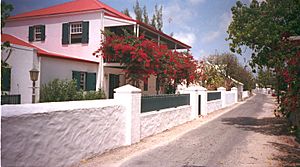
The Turks and Caicos Islands are a British Overseas Territory. This means that Charles III, the King of the United Kingdom, is their head of state. The King is represented by a governor, who is chosen by the King.
The islands got their first constitution (a set of rules for governing) on August 30, 1976. This was when their first Chief Minister, J. A. G. S. McCartney, was elected. Constitution Day is celebrated every year on August 30.
The laws of the territory are based on English common law. People aged 18 and over can vote. English is the official language. Grand Turk is the main administrative and political center, and Cockburn Town has been the seat of government since 1766.
The Turks and Caicos Islands are part of the Caribbean Development Bank and are an associate member of CARICOM. The United Nations Special Committee on Decolonization lists the territory as a non-self-governing territory.
Under the newest constitution from October 2012, the main law-making body is the House of Assembly. It has 19 members: 15 are elected by the people, and 4 are chosen by the governor. Elected members serve for four years. In the 2021 elections, the Progressive National Party won, and Washington Misick became the Premier.
Protecting the Islands
The United Kingdom is responsible for the defense of the Turks and Caicos Islands. The Royal Navy usually has a ship in the Caribbean to help protect British territories and provide aid during disasters like hurricanes.
Turks and Caicos Islands Regiment
In late 2019, Governor Nigel Dakin announced that the Turks and Caicos Islands would create its own defense group, called the Turks and Caicos Islands Regiment. This group will be similar to those in Bermuda and the Cayman Islands. It will help with the nation's security and be trained for natural disasters, focusing on engineering and communications. In June 2020, Lieutenant Colonel Ennis Grant was chosen to lead the new Regiment.
People and Culture
Population and Islands
About 31,458 people lived in the Turks and Caicos Islands in 2012. By July 2021, the population was estimated to be around 57,196. About one-third of the people are under 15 years old. The population is growing quickly. Most islanders (87%) are of African descent. There are also smaller communities of European, mixed-race, and East Indian people. Many people from Haiti and the Dominican Republic also live on the islands.
| Island | Capital | Area (km2) | Population | Native Taino Name | Notes |
|---|---|---|---|---|---|
| Caicos Islands | |||||
| South Caicos | Cockburn Harbour | 21.2 | 2,013 | Kasiba | |
| West Caicos | New Marina | 28 | 10 | Makobisa | Resort staff only |
| Providenciales | Downtown Providenciales | 122 | 33,253 | Yukanaka Yanikana | |
| Pine Cay | South Bay Village | 3.2 | 30 | Buyana | Resort staff only |
| Parrot Cay | Parrot Cay Village | 5 | 90 | Half resort staff, half residential | |
| North Caicos | Bottle Creek | 116.4 | 2,066 | Kaiko | |
| Middle Caicos | Conch Bar | 136 | 522 | Aniyana | |
| Ambergris Cays | Big Ambergris Cay | 10.9 | 50 | ||
| Other Caicos Islands | East Caicos | 146.5 | 0 | Wana | |
| Turks Islands | |||||
| Grand Turk | Cockburn Town | 17.6 | 8,051 | Amuana | |
| Salt Cay | Balfour Town | 7.1 | 315 | Kanamani Kanomani | |
| Other Turks Islands | Cotton Cay | 2.4 | 0 | Makarike | |
| Turks and Caicos Islands | Cockburn Town | 616.3 | 49000 | ||
Languages Spoken
The official language is English. However, many people also speak Turks and Caicos Islands Creole, which is similar to Bahamian Creole. Because the islands are close to Cuba and Hispaniola, there are also large communities that speak Haitian Creole and Spanish.
Religion
Most people in the Turks and Caicos Islands (86%) are Christian. The largest groups are Baptists (35.8%), Church of God (11.7%), and Roman Catholics (11.4%). Other Christian groups include Anglicans, Methodists, and Seventh-day Adventists.
Culture and Traditions
The Turks and Caicos Islands are well-known for their unique ripsaw music. This type of music started on the islands. Every year, the islands host a Music and Cultural Festival. It features local artists and famous musicians from the Caribbean and the United States.
Women on the larger Caicos islands still practice traditional crafts. They use straw to make beautiful baskets and hats. This tradition might be linked to the freed Africans who settled on the islands in the 1830s and 1840s, as they brought these skills with them.
The most popular sports on the islands are fishing, sailing, football (soccer), and cricket. Cricket is the national sport.
Turks and Caicos food mainly features seafood, especially conch. Two popular local dishes are conch fritters and conch salad.
Citizenship and Belonging
Since the Turks and Caicos Islands are a British Overseas Territory, their nationality laws are part of British nationality law. People with strong connections to British Overseas Territories have British Overseas Territories citizenship (BOTC). However, this citizenship doesn't automatically give them the right to live in any British Overseas Territory.
Instead, the right to live and work in the Turks and Caicos Islands comes from something called Belonger status. People who are native to the islands or whose families are from there are called "Belongers." In 2002, all citizens of British Overseas Territories, including the Turks and Caicos, gained full British citizenship.
Education
The Ministry of Education, Youth, Sports and Library Services manages education in the Turks and Caicos. Public education is paid for by taxes and is required for children aged five to sixteen. Primary school lasts for six years, and secondary school lasts for five years.
In the 1990s, efforts were made to improve the skills of primary school teachers. Schools also worked to update their facilities, lower textbook costs, and provide more equipment. For example, in 1993, every primary school received enough books to create in-class libraries.
Public secondary schools include:
- HJ Robinson High School (Grand Turk)
- Clement Howell High School (Providenciales)
- Long Bay High School (Providenciales)
- Raymond Gardiner High School (North Caicos)
- Marjorie Basden High School (South Caicos)
The Turks and Caicos Islands Community College offers free higher education to students who finish secondary school. This college also runs a program to help adults learn to read and write. After completing their education at the Community College, students can study at a university in the United States, Canada, or the United Kingdom for free. In return, they must agree to work in the Turks and Caicos Islands for four years.
Healthcare
The Turks and Caicos Islands started a National Health Insurance Plan in 2010. Residents pay into this plan through their salaries and small fees. Most medical care is provided by hospitals managed by Interhealth Canada. There is one hospital in Providenciales and one on Grand Turk. There are also government and private clinics. The hospitals opened in 2010 and have been officially recognized for their quality since 2012.
Economy
The economy of the Turks and Caicos Islands mainly relies on tourism, international financial services, and fishing. The US dollar is the official currency used on the islands.
Historically, the salt industry, along with small exports of sponges and hemp, supported the islands. The economy started to grow in the 1960s when American investors built an airstrip on Providenciales and the first hotel, "The Third Turtle." This brought a small number of tourists. Later, Club Med built a resort at Grace Bay. In the 1980s, Club Med helped upgrade the airstrip for larger planes, and tourism has been growing ever since.
Most goods, like food and building materials, are imported. In 2010/2011, the government's main income came from import duties, land transaction taxes, work permits, and accommodation taxes. The total value of goods and services produced in the territory was about US$795 million in late 2009.
The main agricultural products are small amounts of maize, beans, cassava (tapioca), and citrus fruits. Fish and conch are the only important exports, mostly sent to the United Kingdom and the United States. However, the amount of fish caught has been decreasing recently.
Tourism: A Major Industry
Tourism is one of the biggest sources of money for the islands. Most visitors come from America, often by cruise ship. In 2007, 264,887 tourists visited, and by 2009, that number grew to 351,498. In 2010, 245 cruise ships arrived at the Grand Turk Cruise Terminal, bringing over 617,863 visitors.
The government is working to increase tourism in two ways. They are building fancy resorts for wealthy visitors. They also built a large new cruise-ship port and recreation center for the many people who visit Grand Turk by ship. The Turks and Caicos Islands have one of the longest coral reefs in the world and the only conch farm.
The French vacation company Club Méditerannée (Club Med) has an all-inclusive resort called 'Turkoise' on Providenciales. The islands have also become popular with celebrities. Many Hollywood stars, like Dick Clark and Bruce Willis, have owned homes there. Ben Affleck and Jennifer Garner got married on Parrot Cay in 2005.
To attract more tourists during the quieter summer months, the Turks and Caicos Tourist Board started an annual music festival in 2003. This festival, held on Providenciales, lasts about a week and has featured many famous international music artists.
Transportation
Providenciales International Airport is the main airport for the Turks and Caicos Islands. JAGS McCartney International Airport serves the capital, Cockburn Town, on Grand Turk. In total, there are seven airports, one on each inhabited island.
The islands have 121 km (75 mi) of highways. Like the United States Virgin Islands and British Virgin Islands, people in the Turks and Caicos Islands drive on the left side of the road. The main international ports are on Grand Turk and Providenciales.
The islands do not have any major railways today. In the early 1900s, East Caicos had a horse-drawn railway. It was used to carry sisal (a plant fiber) from farms to the port. This 14 km (8.7 mi) railway was removed after sisal trading stopped.
Space History
From 1950 to 1981, the United States had a missile tracking station on Grand Turk. NASA used this station in the early days of the American space program. In 1962, American astronaut John Glenn landed in the ocean near Grand Turk after orbiting the Earth three times. He was then brought ashore to Grand Turk.
Postal System
There is no home mail delivery in the Turks and Caicos Islands. People pick up their mail at one of the four post offices located on the major islands. Mail is transported between islands several times a week. The Post Office is part of the territory's government.
Media and Communication
Mobile phone service is provided by companies like Cable & Wireless Communications (Flow brand) and Digicel. The islands are connected to the mainland by two underwater cables and a satellite dish. In 1998, there were three AM radio stations and six FM stations. Power 92.5 FM, which plays popular music, is the most listened-to station.
West Indies Video (WIV) has been the only cable television provider for over two decades. WIV4, a part of WIV, has been the only local broadcast station for over 15 years. Television broadcasts from the Bahamas can also be received. The islands have two internet service providers, and their internet address ends with ".tc".
In 2013, 4NEWS became the islands' first high-definition cable news service. DigicelPlay is the local cable provider. Newspapers in the Turks and Caicos include the Turks and Caicos Weekly News, the Turks and Caicos Sun, and the Turks and Caicos Free Press. All three are published weekly.
Sports
Cricket is the national sport of the islands. The national team plays in regional tournaments. There are also local cricket leagues on Grand Turk and Providenciales.
As of December 2020, the Turks and Caicos Islands' football team was ranked 203rd out of 210 teams in the FIFA World Rankings. Their highest ranking ever was 158th in 2008.
Because the territory is not recognized by the International Olympic Committee, athletes from the Turks and Caicos Islands compete for Great Britain at the Olympic Games.
Notable People
Politics
- Nathaniel Francis (1912–2004): A politician who served as acting Chief Minister from 1985 to 1986.
- Clement Howell (1935–1987): A politician who served on an interim Advisory Council starting in 1986.
- James Alexander George Smith McCartney (1945–1980): Known as "Jags" McCartney, he was the islands' first Chief Minister from 1976 until his death in 1980.
- Ariel Misick (born 1951): A former minister of development and commerce.
- Michael Misick (born 1966): A former chief minister and the first Premier of the islands.
- Washington Misick (born 1950): The current Premier of the Turks and Caicos Islands. He also served as Chief Minister from 1991 to 1995.
- Norman B. Saunders (born 1943): A former politician who served as Chief Minister.
- Oswald Skippings (born 1953): A politician who served as Chief Minister twice, from 1980 and again from 1988 to 1991.
Sports
- Trevor Ariza (born 1985): An American professional basketball player with family roots in Grand Turk.
- Christopher Bryan (born 1960): A sportsman who played both football and cricket for the Turks and Caicos Islands. He became President of the Turks and Caicos Islands Football Association in 2006.
- Errion Charles (born 1965): A sportsman who represented the nation in both football and cricket.
- Billy Forbes (born 1990): A football player who holds the record for most goals for the national team.
- Gavin Glinton (born 1979): A footballer who played for Nam Dinh FC.
- Delano Williams (born 1993): A British sprinter who trains in Jamaica.
Celebrities
- LisaRaye McCoy (born 1967): An American actress and former first lady of the Turks and Caicos Islands.
See also
 In Spanish: Islas Turcas y Caicos para niños
In Spanish: Islas Turcas y Caicos para niños
- Index of Turks and Caicos Islands–related articles
- Outline of the Turks and Caicos Islands




